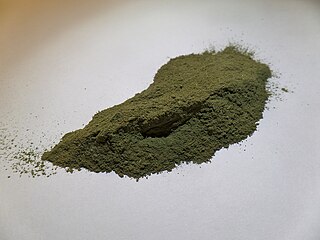
Citric acid is an organic compound with the chemical formula HOC(CO2H)(CH2CO2H)2. It is a colorless weak organic acid. It occurs naturally in citrus fruits. In biochemistry, it is an intermediate in the citric acid cycle, which occurs in the metabolism of all aerobic organisms.

Lead(II) sulfate (PbSO4) is a white solid, which appears white in microcrystalline form. It is also known as fast white, milk white, sulfuric acid lead salt or anglesite.
Triethylamine is the chemical compound with the formula N(CH2CH3)3, commonly abbreviated Et3N. It is also abbreviated TEA, yet this abbreviation must be used carefully to avoid confusion with triethanolamine or tetraethylammonium, for which TEA is also a common abbreviation. It is a colourless volatile liquid with a strong fishy odor reminiscent of ammonia. Like diisopropylethylamine (Hünig's base), triethylamine is commonly employed in organic synthesis, usually as a base.

Dihydrogen phosphate is an inorganic ion with the formula [H2PO4]−. Phosphates occur widely in natural systems.

Ammonium ferric citrate has the formula [NH+4]5[Fe(C6H4O7)2]5−. The iron in this compound is trivalent. All three carboxyl groups and the central hydroxyl group of citric acid are deprotonated. A distinguishing feature of this compound is that it is very soluble in water, in contrast to ferric citrate which is not very soluble.

Disodium citrate, also known as disodium hydrogen citrate, Alkacitron, and sesquihydrate, is an acid salt of citric acid with the chemical formula Na2C6H6O7. It is used as an antioxidant in food and to improve the effects of other antioxidants. It is also used as an acidity regulator and sequestrant. Typical products include gelatin, jam, sweets, ice cream, carbonated beverages, milk powder, wine, and processed cheeses.
Sodium citrate may refer to any of the sodium salts of citric acid :

Hydrogenoxalate or hydrogen oxalate(IUPAC name: 2-Hydroxy-2-oxoacetate) is an anion with chemical formula HC2O−4 or HO−C(=O)−CO−2, derived from oxalic acid by the loss of a single proton; or, alternatively, from the oxalate anion C2O2−4 by addition of a proton. The name is also used for any salt containing this anion. Especially in older literature, hydrogenoxalates may also be referred to as bioxalates, acid oxalates, or monobasic oxalates. Hydrogenoxalate is amphoteric, in that it can react both as an acid or a base.

In chemistry, methanetetracarboxylate is a tetravalent anion with formula C5O4−8 or C(−CO−2)4. It has four carboxylate groups attached to a central carbon atom; so it has the same carbon backbone as neopentane. It is an oxocarbon anion, that is, consists only of carbon and oxygen.

Ferrous citrate, also known as iron(II) citrate or iron(2+) citrate, describes coordination complexes containing citrate anions with Fe2+ formed in aqueous solution. Although a number of complexes are possible (or even likely), only one complex has been crystallized. That complex is the coordination polymer with the formula [Fe(H2O)6]2+{[Fe(C6H5O7)(H2O)]−}2.2H2O, where C6H5O73- is HOC(CH2CO2−)2(CO2−, i.e., the triple conjugate base of citric acid wherein the three carboxylic acid groups are ionized. Ferrous citrates are all paramagnetic, reflecting the weak crystal field of the carboxylate ligands.

Sodium tetrachloroaurate is an inorganic compound with the chemical formula NaAuCl4. It is composed of the ions Na+ and AuCl4−. It exists in the anhydrous and dihydrate states. At room temperature, it exists as a golden-orange solid. The anhydrous and dihydrate forms are available commercially.

Germanium(IV) iodide is an inorganic compound with the chemical formula GeI4.

Dithymoquinone is a bioactive isolate of Nigella sativa. Chemically, it is a dimer of thymoquinone.

18-Deoxyaldosterone is a steroidal antimineralocorticoid with mixed agonist–antagonist but predominantly antagonistic activity at the mineralocorticoid receptor.
4-Chlorobenzaldehyde is an organic compound with the chemical formula C7H5ClO. It can be produced by the oxidation of 4-chlorobenzyl alcohol. It can be further oxidized to 4-chlorobenzoic acid. It will react with malononitrile to form 4-chlorobenzylidenylmalononitrile. 4-Chlorobenzaldehyde reacts with benzylamine to produce N-(4-chlorobenzylidenyl)benzylamine。
Trisodium borate is a chemical compound of sodium, boron, and oxygen, with formula Na3BO3, or (Na+)3[BO3]3−. It is a sodium salt of the orthoboric acid B(OH)3.
Alkali citrate is an inhibitor of kidney stones. It is used to increase urine citrate levels - this prevents calcium oxalate stones by binding to calcium and inhibiting its binding to oxalate. It is also used to increase urine pH - this prevents uric acid stones and cystine stones.
Bromocyclopropane is a organobromine compound with the chemical formula C3H5Br. It is a member of haloalkane family.

Azomethane is an organic compound with the chemical formula CH3-N=N-CH3. It exhibits cis-trans isomerism. It can be produced by the reaction of 1,2-dimethylhydrazine dihydrochloride with copper(II) chloride in sodium acetate solution. The reaction produces the azomethane complex of copper(I) chloride, which can produce free azomethane by thermal decomposition. It is the source of methyl radical in laboratory.














